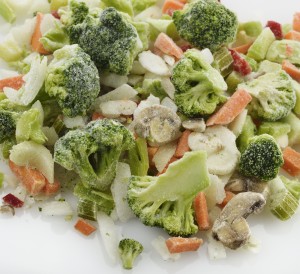Listen to me talk about this article in my podcast.
In honor of frozen food month, let’s find the produce selections that are good deals in March, and freeze them ourselves. March is the prime month for the items below, and we’ve included tips on freezing them well. Two of the other great March items are lettuce and radishes, and we wanted to mention them, even though you can’t freeze either one.
FRUITS
Mango: You can choose either sweetened or unsweetened preservation. First, select mangos that are ripe, but still fairly firm, with slight give under gentle pressure. Next, wash, peel and slice them. Then, if packing in syrup, add to a freezer container, leaving room for expansion as it freezes, and for 30% syrup solution. To make the syrup, use this recipe list from the National Center for Home Food Preservation to choose from very light to heavy syrup. After syrup is ready, add to freezer pack, then freeze.
If packing unsweetened, simply lay mango slices on a cookie sheet and freeze individually, then transfer to freezer bags.
Pineapple: Select pineapple that is ripe, aromatic, and full of flavor. Remove exterior, core and eyes. Cut into desired style (dices, slices, wedges) or even crush it in a food processor. Pack tightly into freezer containers without any sugar, leaving room for expansion as it freezes.
VEGETABLES
Artichokes: Before freezing, artichokes must be cooked. Check out the California Artichoke Advisory Board website for 3 methods to properly cook and freeze them.
Broccoli: The key to freezing broccoli is to get heads that are as fresh as you possibly can. Fresh broccoli will have tightly closed florets, with no yellow on them. Rinse in cold water, then split the head into sections about 1.5 inches across. Remove the woody parts of the stems and any leaves. Boil in water, then immediately plunge into ice water ““ 3 minutes in each. Drain thoroughly before sealing in a freezer bag.
Brussels sprouts: Little bugs like to hide under the first couple layers of the leaves, so start by soaking your sprouts in salt water for at least 30 minutes. Remove any yellowed leaves and trim off stems. Sort sprouts by size, to prevent over- or under-blanching. Blanch in boiling water, and shock in ice water for identical times. For the small sprouts, 3 minutes in each; medium sprouts, 4 minutes; and large sprouts 5 minutes. Immediately set on cookie sheets to freeze the sprouts individually, then transfer to freezer bags.
Cauliflower: Treat this veggie just as you would broccoli.
Leeks: Leeks that have been frozen are perfect for soups or casseroles. First, chop off the little roots and the dark green leafy end. Cut in half lengthwise, and chop into small, even sized pieces. Place in a colander, then set the colander into a larger bowl filled with cold water. Swish colander around to remove any dirt stuck to the leek pieces, and allow dirt to settle to the bowl bottom. Quickly pull up the colander to remove the leeks without getting any dirt back on them. Shake over the sink to remove as much water as possible, then lay them out on a clean, dry towel to fully air dry. After leeks are dry, freeze on cookie sheets before portioning and moving to freezer bags.
Mushrooms: These turn out best when they are first dipped for about 5 minutes in lemon water (1 teaspoon lemon juice to 1 pint water). Then steam for 5 minutes for whole mushrooms, 3 minutes for slices. Cool immediately in cold water, drain thoroughly, pat off excess water, pack and freeze.
Another choice for freezing mushrooms is to not get them wet at all. Simply wipe gently with a clean, lint-free cloth. Freeze individually on cookie sheets without steaming or slicing, then pack and freeze.
Parsnips: The trick to parsnips is to make sure that they are fresh to begin with ““ and you don’t blanch them over a couple minutes. Start by washing, peeling, and cutting into 1/2 inch cubes. Blanch for 2 minutes in boiling water, then immediately plunge into ice water for 2 minutes. Drain thoroughly, pack and freeze.
Rutabagas: Cut off the tops, wash, peel, and cut into 1 inch cubes. Blanch in boiling water, then shock in ice water – 3 minutes in each. Drain and pack into freezer bags.
Alternatively, you can also freeze parsnips mashed. Prepare, then cook until tender, drain, and mash, before packing and freezing.
Turnips: Treat them as you would parsnips.
Four more freezing tips: You can freeze almost anything. Of course, how they are used later can change as texture and flavor can change with freezing. If you aren’t sure if something can be frozen, or how to freeze it, a quick search online will answer your questions.
When freezing in batches, you can reuse the same boiling water 4-5 times if you are blanching the same vegetable each time. Use a steam basket or metal slotted spoon to remove vegetables without draining the water. The key is to be fast to avoid over-blanching. Over-blanching will result in mushy frozen vegetables later.
If you are packing in simple freezer bags, be sure to press out as much air as you possibly can. Some people have success sucking out excess air through a straw before pinching shut the very last bit of a freezer bag. In whatever way you are able to do it, getting out as much air as you can is crucial to great freezing.
And finally, label your freezer bags or containers before you begin. It is easier to write on them, less likely to smear off, and you will get the ready produce into the freezer more quickly. Freezing as close to when you finish blanching is important. Some produce needs to air dry (like leeks), but others can develop mold if not frozen quickly. Some foods don’t do well staying moist in a warm kitchen.



